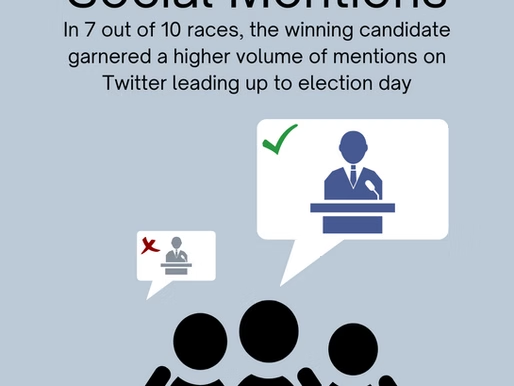Key Points
The 2022 midterm elections delivered unexpected results that remain difficult to explain.
-
Social data from the unprecedented 2022 Senate midterm elections showed little evidence for the strong connection between candidates’ Twitter followership and their likelihood of victory.
By the Numbers:
-
In 7 out of 10 battleground Senate races, winning candidates had a greater number of Twitter followers than their opponents.
-
In 7 out of 10 battleground Senate races, winning candidates garnered at least 15% more Twitter mentions than their opponents.

Where We Stand: The Midterms are Over
Well, that was unexpected.
Now that the Senate race has officially been called, we can begin to try and make some sense of the unexpected 2022 midterm results. What was predicted to be a referendum on the 46th president is now being called a repudiation of the 45th as a red wave failed to materialize, and democrats outperformed the majority of projections – gaining a seat in the Senate (51-49 majority) and losing fewer than expected in the House.
If you’ll recall from our first article in this two-part series, we examined various Twitter metrics to determine if any could be used to predict campaign success. So, were we able to accurately predict the outcome of the elections? Like nearly all others who tried – 538, CNN, Fox News, etc. – we can confidently say, “of course not.” But that doesn’t mean that our social data is not beginning to paint a more interesting picture.
The goal of our analysis was never really to predict election results (though we did try), but rather to gain insight into all the factors that play into the public temperature surrounding particular races and candidates. Going forward, we will continue to collect large amounts of social data to better understand what social media can reveal about our national elections. For now, we’re excited to share with you our first post-election analysis in which we closely examined three social variables (followership growth, followership, and earned mentions) to see what, if anything, they could tell us about these unprecedented 2022 elections.
Analysis and Results
-
FOLLOWER GROWTH: We first looked at a metric we’ve been tracking since the primaries: followership growth. Earlier in the fall, we analyzed 17 primary races to better understand which aspects of a candidate’s Twitter presence factored most heavily into his or her potential victory. What we found then, among other things, was that the candidate who saw the greatest growth in Twitter followership in the two months leading to their primary had a much greater likelihood of winning. We were excited to see if this finding would hold in the November midterms, and we were a bit disappointed when we found that it did not. In fact, in only 3 of our 10 sampled battleground races, we see this trend continue. Instead, in 7 out of 10 of our races, the winner experienced less Twitter followership growth than his or her opponent in the two months leading up to the election. It’s difficult to say if our differing results were due to any inherent differences between the primaries and the general election, but we will continue to record election data in order to better understand this trend (or lack thereof).
-
FOLLOWERSHIP: Additionally, we examined each candidate’s Twitter followership as a potential indicator of campaign success, and the results were a bit more interesting. Behind this was the loose hypothesis that the candidate with the greatest reach would likewise receive the most votes. When looking at each candidate’s Twitter followership on the Friday prior to election day, we found that in 7 out of 10 races, the winner was the candidate with a greater number of Twitter followers. Interestingly in 2 of the 3 races where this didn’t hold true, the winner had fewer followers but greater followership growth in the two months leading to the election.
-
EARNED MENTIONS: Finally, we conducted a high-level earned content analysis to try and determine whether or not conversation volume surrounding specific candidates had any implications toward candidate success. Here again, we found that 7 out of 10 winning candidates were discussed more frequently than their opponents, indicating that candidates who generated larger conversations had a slightly higher likelihood of victory than their opponents. At the minimum, Mark Kelly, who defeated Blake Masters in Arizona, garnered 16% more mentions than his opponent. In the most extreme case, Mike Lee, who defeated Evan McMullin in Utah, generated a Twitter conversation 521% larger than his opponent.
It is also worth noting that there were no significant findings regarding conversation sentiment – that is, no obvious trend emerged that would lead us to believe that online sentiment can reveal any insight about voting patterns and election results at this stage of the analysis.
Conclusion
At the moment, we can’t definitively say whether any of the above factors played significant roles in the outcomes of November’s midterm elections, but that’s not exactly what this analysis was designed to do. This analysis is the first of many, a starting point to a larger initiative wherein Ringer will collect social data surrounding all forthcoming national elections in order to see if, year-over-year, any interesting trends emerge. So far, we’ve only identified a few potential indicators of campaign success, but we’re looking forward to the 2024 elections, which will bring new batches of data and certainly some interesting insights.
Data Parameters
The analysis is based on social data from candidates in the 10 defined battleground Senate races:




